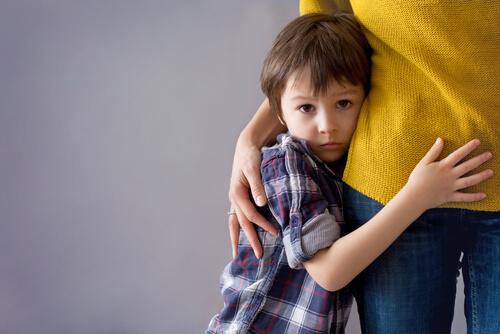5 Activities for Teaching Children to Overcome Their Fears

Teaching children to overcome their fears is no easy task. This is a natural phase that children go through, but a complicated one.
You’ll need plenty of patience in addition to the tips you’ll find in this article.
As a parent, teaching children to overcome their fears can be frustrating. Fears can be irrational.
Often, nothing you say seems to help your child get over their anxiety. You may be at a loss as to what to try next.
Children sometimes develop a fear of certain situations or objects which, to our adult eyes, don’t seem threatening at all. This occurs across all cultures.
Childhood fears are a universal part of the process of growing up.
Teaching children to overcome their fears usually becomes necessary at around a year of age. By the time your child is four to six years old, this tendency can become more pronounced.
Most fears are just another phase of children’s development. In some exceptional cases, however, psychological help is needed.
The sources of this fear may change as your child grows older. For example, fear of the dark or monsters under the bed can transform into a fear of strangers or violence.
Childhood fears: factors to be aware of
It’s important to keep in mind certain factors when teaching children to overcome their fears.
- Teasing children or forcing them to confront what they’re afraid of may only make matters worse.
- You can help your child by taking their fears seriously and encouraging them to talk about how they feel.
- Above all, never attack your child for being afraid or force them into situations they find scary.
- To help your child get over their fear, you must acknowledge their feelings.
- Encouraging your child to talk about the things that make them feel anxious will give them the opportunity to face their fears at their own pace and with all your support.
What makes children afraid?
Some children are more fearful than others. Here are some of the factors that contribute to childhood fears:
- Genetic susceptibility: some children are naturally more sensitive and have a more emotional temperament.
- Anxiety in parents: children learn how to behave by watching their parents.
- Overprotective parenting: children who are highly dependent on their parents may feel incapable, leading to general anxiety.
- Stressful circumstances: certain situations, such as separation from parents, an injury or period of hospitalization, may have a significant effect on your child.

5 activities for teaching children to overcome their fears
Here are 5 activities that will help your child get over their fears. Try to put these tips into practice:
1. Read books about fear and overcoming it
Telling stories, acting out situations or reading a book about a frightening situation can all help the child get over their fear.
This strategy is sometimes known as bibliotherapy or expressive storytelling. It’s useful because children are often able to identify with a character who is facing the same problem.
2. Use art and crafts
Creative activity can allow children to address their subconscious fears. When a child isn’t able to talk about their fears, a blank page is a good tool to address what is on their mind.
Once the child has drawn a picture of the thing that frightens them, you’ll be able to discuss their fear and look for a solution together.
“Above all, never attack your child for being afraid or force them into situations they find scary”
3. Make a ranking
Have your child make a list of the things they’re afraid of. Then help them organize this list from least to most terrifying.
You could also use the idea of a thermometer to help your child assess each fear from hot to cold.
Smaller children may need help to do this, but they’ll usually be able to tell you which situations they find more frightening than others.
Once your child has ranked each situation, use the idea to talk about the fears on their list.

4. Play hide-and-go-seek
This popular childhood game does more than just keep kids entertained. It teaches us about abandonment and separation.
Playing hide-and-go-seek will help your child face their fear of being alone.
5. Admit when you’re afraid
Tell your child about the things that frighten you, and let them know what you do to get over your fears. Learning from your example will help your child overcome this difficult phase.
Your child imitates you and the feelings you experience and express. By sharing your own experiences, you’ll teach your child to tell you how they feel.
There are a lot of ways of teaching children to overcome their fears. Which one you choose will depend on your child.
The most important tip of all, however, is for you to be there for your child and support them.
Your little one needs you by their side to overcome their fears, which are a typical part of childhood.
All cited sources were thoroughly reviewed by our team to ensure their quality, reliability, currency, and validity. The bibliography of this article was considered reliable and of academic or scientific accuracy.
- Aguilar Melchor, J. M. (2022). Tratamiento cognitivo-conductual de fobia a la oscuridad: un estudio de caso. Máster de Psicología General Sanitaria, Universidad Europea de Madrid. https://titula.universidadeuropea.com/handle/20.500.12880/2116
- Herringa, R. J., Birn, R. M., Ruttle, P. L., Burghy, C. A., Stodola, D. E., Davidson, R. J., & Essex, M. J. (2013). Childhood maltreatment is associated with altered fear circuitry and increased internalizing symptoms by late adolescence. Proceedings of the National Academy of Sciences, 110(47), 19119–19124. https://www.pnas.org/doi/full/10.1073/pnas.1310766110
- Méndez, F. X., Inglés, C. J., Hidalgo, M. D., García-Fernández, J. M., & Quiles, M. J. (2003). Los miedos en la infancia y la adolescencia: un estudio descriptivo. Revista Electrónica de Motivación y Emoción, 6(13), 150-163. http://reme.uji.es/articulos/amxndf4650710102/texto.html
- Rafihi-Ferreira, R. E., Alckmin-Carvalho, F., Silvares, E. F. D. M., & Ollendick, T. (2021). Biblioterapia para Medos Noturnos em Crianças: Um Estudo de Caso. Psicologia: Ciência e Profissão, 41. https://www.scielo.br/j/pcp/a/Qbn5VLxJNpMyygDH5B8S9jP
- Sandín, B., Chorot, P., Valiente, R. M., & Germán, M. Á. S. (1998). Frecuencia e intensidad de los miedos en los niños: Datos normativos. Revista de Psicopatología y Psicología Clínica, 3(1), 15-25. http://revistas.uned.es/index.php/RPPC/article/view/3853
- Sias Salas, S. S., Ayala Escandón, C. de la L., & Pichardo Solís, V. A. (2021). El dibujo como medio de evaluación del miedo/ansiedad en niños de 5 a 8 años en atención dental. Estudio descriptivo. Revista De Odontopediatría Latinoamericana, 8(2). https://www.revistaodontopediatria.org/index.php/alop/article/view/155
- Valiente, R. M., Sandín, B., & Chorot, P. (2002). Miedos comunes en niños y adolescentes: Relación con la sensibilidad a la ansiedad, el rasgo de ansiedad, la afectividad negativa y la depresión. Revista de psicopatología y Psicología clínica, 7(1), 61-70. http://revistas.uned.es/index.php/RPPC/article/view/3922